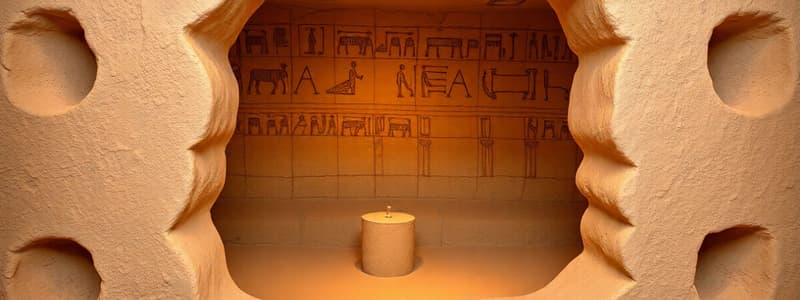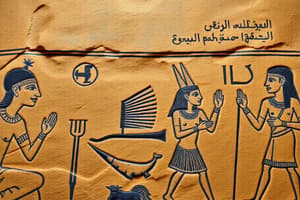Podcast
Questions and Answers
Cave art from Lascaux, France, suggests what about early humans?
Cave art from Lascaux, France, suggests what about early humans?
- They developed complex mathematical systems to create perfectly proportioned images.
- They primarily used art for religious ceremonies and ancestor worship.
- They focused on creating realistic depictions of battles and historical events.
- They utilized art as a means of communication and to connect with their environment. (correct)
What material was commonly used for sculptures and monuments in Egyptian art?
What material was commonly used for sculptures and monuments in Egyptian art?
- Stone (correct)
- Metal
- Papyrus
- Wood
How did Egyptian artists typically portray figures in their artwork?
How did Egyptian artists typically portray figures in their artwork?
- Frontal poses with heads and legs in profile. (correct)
- Abstract forms with symbolic representations.
- Dynamic poses with realistic movement.
- Exaggerated proportions to emphasize power.
What innovation did Greek artists use to create lifelike figures with a sense of movement and balance?
What innovation did Greek artists use to create lifelike figures with a sense of movement and balance?
What was a primary medium used by Greek artists, especially for sculptures that allowed for fine detail?
What was a primary medium used by Greek artists, especially for sculptures that allowed for fine detail?
Which architectural element, popularized by the Romans, allowed for the construction of larger and more complex structures?
Which architectural element, popularized by the Romans, allowed for the construction of larger and more complex structures?
What was the main purpose of Roman art?
What was the main purpose of Roman art?
What is a defining characteristic of Medieval art?
What is a defining characteristic of Medieval art?
Which artistic medium was commonly used in Medieval art to adorn cathedrals with vibrant colors and depictions of biblical stories?
Which artistic medium was commonly used in Medieval art to adorn cathedrals with vibrant colors and depictions of biblical stories?
What distinguishes the style of Medieval art?
What distinguishes the style of Medieval art?
What media are traditionally used in Chinese painting?
What media are traditionally used in Chinese painting?
What are the main styles in Chinese painting?
What are the main styles in Chinese painting?
What concept does Chinese painting primarily express?
What concept does Chinese painting primarily express?
What does the term 'Ukiyo' mean in the context of Japanese art?
What does the term 'Ukiyo' mean in the context of Japanese art?
What is the primary purpose of Ukiyo-e?
What is the primary purpose of Ukiyo-e?
Which printing technique is most associated with Ukiyo-e?
Which printing technique is most associated with Ukiyo-e?
During which period did Ukiyo-e emerge in Japan?
During which period did Ukiyo-e emerge in Japan?
What is the technique called that Ukiyo-e artists often used to create color gradients and depth?
What is the technique called that Ukiyo-e artists often used to create color gradients and depth?
Which medium was crucial for creating illuminated manuscripts during the Medieval period?
Which medium was crucial for creating illuminated manuscripts during the Medieval period?
Which of the following civilizations influenced Greek art?
Which of the following civilizations influenced Greek art?
Flashcards
Art Movement
Art Movement
A collective name for works of art sharing a common style, philosophy, and technique.
Ancient Art
Ancient Art
Creations from early civilizations to classical antiquity, reflecting human expression and cultural values.
Cave Art
Cave Art
Art dating back 40,000 years ago, using natural pigments for communication and connection with the environment.
Egyptian Art
Egyptian Art
Signup and view all the flashcards
Greek Art
Greek Art
Signup and view all the flashcards
Roman Art
Roman Art
Signup and view all the flashcards
Medieval Art
Medieval Art
Signup and view all the flashcards
Asian Art
Asian Art
Signup and view all the flashcards
Chinese Painting
Chinese Painting
Signup and view all the flashcards
Ukiyo-e
Ukiyo-e
Signup and view all the flashcards
Study Notes
Art History
- An art movement is a collective name given to artworks sharing a common style, philosophy, and technique.
Ancient Art
- Ancient art spans creations from early civilizations to classical antiquity.
- It showcases human expression and cultural values throughout history.
- Examples include Cave, Egyptian, Greek, and Roman art.
Cave Art
- Emerged approximately 40,000 years ago, marking the start of human art.
- Paintings in Lascaux, France feature animals, human figures, and abstract symbols.
- This suggests early humans used art for communication and connection with their environment.
- Natural pigments like ochre, charcoal, and minerals mixed with animal fats or water were used as media.
- They were applied using primitive tools like twigs or animal hair.
- Simple forms, silhouettes, and outlines were used as styles.
- Dynamic animals like bison, horses, and deer appear with hand stencils and geometric patterns.
- It was likely used for hunting rituals and documenting significant events.
- Specific artists are unknown, but the art reflects a collective cultural effort of early hunter-gatherer societies.
Egyptian Art
- Flourished from 3000 BCE to 30 BCE.
- Focused on the afterlife and honoring gods and pharaohs.
- Stone, wood, metal, and papyrus were used as media.
- Stone was common for sculptures and monuments.
- Wood was used for smaller artifacts.
- Metal was used for decorative items.
- Papyrus was used for painting and writing.
- The hieratic scale was a common style where larger figures indicate higher status.
- Karnak Temple features colossal statues of gods and pharaohs.
- Figures are often shown in frontal poses, with heads and legs in profile.
- Symbolism is crucial, with colors and icons carrying meanings, like green for fertility and rebirth, seen in depictions of Osiris and the ankh for life.
- Primary purposes were religious and funerary.
- Art was made for temples or tombs, aiding the deceased's journey to the afterlife.
- Imhotep, an architect and physician, and pharaohs are significant figures; pharaohs acted as art patrons.
Greek Art
- From 800 BCE to 30 BCE, influenced Western culture.
- Emphasized beauty, humanism, and idealized representations of the human form.
- Media included marble, bronze, and pottery.
- Marble enabled fine detail in sculpture, while bronze facilitated dynamic poses.
- Pottery includes the black-figure François Vase and the red-figure Panathenaic Amphora, serving practical and decorative uses.
- Naturalism in sculpture was shown as a style.
- Contrapposto was employed to create lifelike figures with movement and balance.
- It celebrated human achievement, explored mythology, and honored the gods.
- Art was often created for public spaces and temples, reflecting civic pride.
- Phidias, known for the statue of Zeus at Olympia and the Parthenon sculptures and Praxiteles, known for a relatable and sensual approach (Aphrodite of Knidos), were significant artists.
Roman Art
- From 500 BCE to 500 CE.
- Adapted Greek influences while emphasizing realism and everyday life, reflecting Roman society's complexity.
- Marble, frescoes, and mosaics were used as media.
- Marble provided durability and detail, frescoes added vibrant color and narrative depth, and mosaics featured intricate designs using tiny colored stones or glass.
- The style had a focus on portraiture, particularly busts capturing likeness and character.
- Architectural innovations like the arch and dome enabled larger structures, such as the Pantheon and Roman Aqueducts.
- It aimed to convey power, commemorate achievements, and reflect cultural values.
- Public monuments honored emperors and heroes, reinforcing their status.
- Art in private homes reflected social standing.
- Augustus, the first Roman emperor, influenced art through his patronage, promoting idealized imagery of power.
- Vitruvius, a prominent architect, authored “De Architectura,” emphasizing proportion and functionality in Roman building practices.
Medieval Art
- From 500 to 1400 CE.
- Deeply influenced by the church, focusing on religious themes.
- Illuminated manuscripts, stained glass windows, and sculpture were used as media.
- Illuminated manuscripts had intricate illustrations on parchment.
- Stained glass windows adorned cathedrals, filtering light through vibrant colors and depicting biblical stories.
- Sculpture often decorated church façades and altars to convey religious narratives.
- Style was noted for its flat, symbolic representations.
- Paintings and illuminated texts emphasized outlines and bold colors over realistic proportions.
- Figures were stylized, prioritizing spirituality rather than naturalism to align with the educational purpose of art.
- Primary purposes were to educate and inspire religious devotion.
- It was a visual narrative conveying biblical stories and teachings, fostering contemplation and spiritual connection during worship.
- Many artists are anonymous, as individual recognition was less common.
- Much of the artwork was created by monks dedicated to spiritual and artistic pursuits.
- Examples include illuminated manuscripts such as the Book of Kells and the works of the Limbourg brothers in the Très Riches Heures du Duc de Berry.
Asian Art
- Reflects the continent's rich cultural heritage, diverse religions, and philosophies.
- Expresses cultural identity while evolving alongside traditional practices.
- Notable forms include Chinese painting and Ukiyo-e (Japanese print).
Chinese Painting
- Rooted in ancient traditions, emphasizing harmony with nature and philosophical concepts.
- Traditional works primarily used ink and brush on silk or paper, with ink made from natural materials resulting in varying tones.
- Silk has been favored for centuries, while rice paper is commonly used in more recent works.
- The two main styles are landscape and calligraphy.
- Landscape painting depicts serene mountains, rivers, and forests.
- Calligraphy complements paintings and conveys philosophical ideas.
- It expresses spiritual and philosophical concepts.
- Artists strive to convey the essence of nature and emotions/ideas like harmony, balance, and the transient nature of life.
- These artworks serve as meditative objects for viewers.
- Wang Wei, a Tang dynasty artist known for his tranquil landscapes, was a significant artist.
Ukiyo-e (Japanese Print)
- Emerged in Japan during the Edo period (1603-1868).
- Ukiyo means "pictures of the floating world," celebrating the beauty of everyday life.
- Woodblock printing was used for mass production.
- Artists carved images into wooden blocks, applied ink, and pressed paper onto the blocks to create prints.
- Style is known for vibrant colors, bold lines, and perspective; bokashi was used to create color gradients and depth.
- The primary purpose was to capture fleeting moments in landscapes, kabuki actors, beautiful people (bijin), and scenes from popular stories.
- Katsushika Hokusai, famous for The Great Wave off Kanagawa, and Utagawa Hiroshige, known for his landscape series Fifty-Three Stations of the Tōkaidō, were significant artists.
Studying That Suits You
Use AI to generate personalized quizzes and flashcards to suit your learning preferences.




